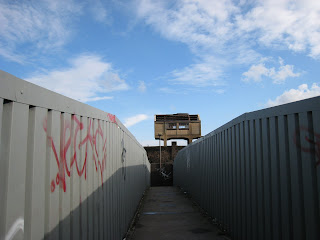Today as I am about to turn the corner from Brick Lane into Pedley Street I have a sense of anticipatory suspense. I know this pocket has been due for radical change, the days of the signal box numbered – the days of in-between-ness marked to give way to an opening up – the march of regeneration. I had heard that the slow encroachments had stepped up – from fenced off areas, tube closure, now to road closure; access denied. The chink of freedom in the overlooked Fleet Street Hill cobbled road, the bowel of the railway arch gradually backed up.
I feel the earth shuddering before I see why. The road is blocked at the Brick Lane end with a massive road-wide chunk of concrete. The Winos’ corner habitat is obliterated. The railway embankment to the left looks as if the top has been sawn off. I step past the concrete and continue along the cobbled anyway-narrow street – today even narrower, bisected by temporary orange fencing, and beyond the plastic fencing a ten-foot high wooden barrier encroaching into the park, the reverse side visible. A sign attached to the orange fencing reads ‘DIVERSION. FOOTPATH CLOSED’ – stating the very obvious.
Two workmen are hacking into the street ahead. I pause before I reach them and watch up to my left. I can see the open top of a lorry, backing at right angles towards the edge of the embankment. The lorry lifts its open top, which I see now, is filled with rubble. The tons of grey rocks are emptied down into a wide chute, as wide as a road, down the side of the bank. The rubble slides and pours with a release like long slow moaning thunder.
I continue along what’s left of Pedley Street. The cumulative hacking and pouring visibly contributing to the shuddering earth beneath my feet, but not fully explaining it – something over and beyond the mound of the railway, out of sight, must be responsible. The once isolated lonely spot is active and noisy, opened up, and at the same time sealed off. I expect as I turn the corner to the left, towards the railway arch, that here too will be mechanical busy-ness: the arch subjected to the same process, being cleaned and ordered and exposed. The wood yard to the left is scoured out; now workmen instead of salvage and wood clutter the yard. But ahead into the darkness of the railway arch I see that rather than the order and busy-ness I thought I might find, the arch is in its scummy element – perhaps having sucked in all the atmospheric degeneracy that’s been washed away around it.
The once pristine Joiners sign at the far end, for the Joiners/wood yard trolls beneath the railway, is defaced; there is no dim light shining out from the cracks in the panels of the arch. The floor of the arch has pools of something, strewn with bits of something else; unidentified stuff. I look along the sides of the arch for traces of familiar posters and graffiti. But the walls have blended into one mottled surface, like a paint palette mixed with too many colours till it becomes a murky substance. At the end of the arch, in the corner by the stairwell, the usual depository of fires and general crap, is the biggest and best ever heap of smouldering filthy unidentifiable masses – part clothes, part car, part electrical innards, part sweet wrappers. I step beyond and up the first flight of stairs to the bridge, which doesn’t let up in its hyped-up last blow out of filth. I step from side to side, holding my jeans up slightly, past condoms and turds. I turn the corner to the next flight of steps, and continue sidestepping more shit, and general sludge and slime. The bridge top is a wind tunnel of cans and packets and wrappers; a breath of fresh air from the dank urine and excrement flavour of the stairs. I descend the stairs at the other side; carefully and slowly, mindful of the slippery surface and the memory of Serena’s fall, bum and hand down into the muck. At street level, in the semi ‘courtyard’ formed between the end of the bridge, a yard door, and the windowless sides of two buildings - usually a last resting place for computer insides and outsides – the creep of the changes is visible too. The usually locked up high-gated yellow doors of the yard are flung wide open for the first time ever, to reveal an empty cleansed space. And a large clean shiny car occupies the space of the computer detritus.




























